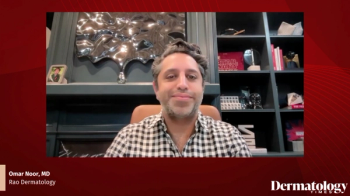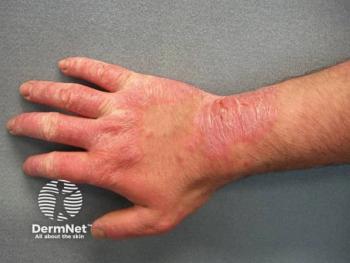
RAD 2025 Poster Highlights Ruxolitinib Cream Safety in Combination AD Regimens
Key Takeaways
- Ruxolitinib 1.5% cream combined with systemic therapies showed a favorable safety profile, with mild and infrequent adverse events reported in a multi-center retrospective study.
- No serious adverse events, including malignancies or infections, were observed, indicating the combination therapy's safety for moderate to severe atopic dermatitis.
Recent research presented at the 2025 RAD Meeting explored the use of ruxolitinib cream in combination with systemic therapy.
Managing moderate to severe atopic dermatitis (AD) frequently requires systemic therapies, yet topical treatments remain indispensable, often as part of combination regimens.1 Ruxolitinib (RUX) 1.5% cream, a topical JAK1/2 inhibitor, is currently approved for mild to moderate AD as monotherapy, with labeling cautioning against concomitant systemic agents. A recent multi-center retrospective study, presented as a poster at the
Study Methods
The multi-center retrospective analysis was undertaken to provide real-world insights into the safety and clinical outcomes associated with the long-term use of RUX 1.5% cream when incorporated into combination regimens with systemic therapies for the management of atopic dermatitis. Researcher’s aim was to inform clinical decision-making by bridging the gap between current labeling and practical patient management needs.
The study involved a meticulous multi-center retrospective chart review, encompassing data from 115 AD patients who received RUX 1.5% cream alongside systemic agents. Patient records from February 1, 2022, to January 1, 2023, were scrutinized. Patients were categorized into 2 distinct cohorts: Cohort A (n=73) consisted of patients who initiated RUX 1.5% cream and subsequently had a systemic therapy added, reflecting an escalation in treatment. Cohort B (n=42) included patients who began RUX 1.5% cream while already on an ongoing systemic therapy, representing an adjunctive use. Comprehensive data extraction included patient demographics, baseline disease characteristics, concomitant systemic therapies, observed adverse events (AEs), efficacy outcomes (Investigator Global Assessment [IGA], Body Surface Area [BSA], and patient-reported itch scores), and details regarding treatment discontinuations and their reasons.
Results
Baseline demographic and clinical characteristics were largely comparable between the 2 cohorts. The mean age in cohort A was 37.8 years (range 18-69), and in cohort B, 37.0 years (range 18-72). The mean duration of RUX use in combination with another systemic therapy was substantial, averaging 16.8 ± 8.7 months in cohort A and 21.0 ± 12.3 months in cohort B, highlighting prolonged real-world use. Dupilumab was the predominant systemic agent employed across both cohorts (83.6% in cohort A, 72.3% in cohort B), with a smaller proportion of patients utilizing other JAK inhibitors (2.7% in cohort A, 11.9% in cohort B).
Critically, regarding safety, researchers stated the vast majority of patients exhibited no adverse events. Specifically, a remarkable 97.3% (71/73) of patients in cohort A and 87.8% (37/42) in cohort B reported no AEs. The few AEs observed were mild and infrequent, including only 1 case (2.9%) of injection site reaction with concomitant dupilumab. Other infrequent AEs included acne (1.5% cohort A), eyelid dermatitis (1.5% cohort A), central retinal vein occlusion (1.5% cohort B), and vision changes (1.5% cohort B). Importantly, and of significant clinical reassurance, no cases of malignancy, serious infections, or death were reported in either cohort. Furthermore, no novel safety signals emerged that were not already documented in the established safety profile of ruxolitinib monotherapy. This finding strongly suggests that combination therapy with RUX cream does not introduce unforeseen safety risks.
Efficacy outcomes at week 52 were compelling, demonstrating substantial improvements across key clinical measures. In cohort A, mean changes from baseline were impressive: IGA -2.57 ± 0.54, BSA -8.03 ± 2.17, and itch score -8.04 ± 0.37. Cohort B similarly showed robust improvements with mean changes of IGA -2.38 ± 0.54, BSA -22.62 ± 4.94, and itch score -6.18 ± 0.27. These efficacy data underscore the real-world clinical benefit achievable with this combination approach.
Discontinuation rates for ruxolitinib were 13.7% (10/73) in cohort A and 26.8% (11/42) in cohort B. Reasons for discontinuation varied, including lack of efficacy (1.5% cohort A, 2.0% cohort B), disease flare (1.5% cohort A, 2.9% cohort B), secondary failure (2.9% cohort A, 1.0% cohort B), coverage issues (1.5% cohort A, 1.0% cohort B), and AD clearance (1.5% cohort A). A notable proportion were due to reasons otherwise undefined (5.5% cohort A, 3.8% cohort B), as is often seen in retrospective analyses.
Conclusion
In conclusion, this real-world analysis provides compelling evidence that RUX 1.5% cream, when utilized in combination with systemic therapies for AD, demonstrates a favorable safety profile characterized by mild and infrequent adverse events, with no new safety signals emerging. More importantly, the study reveals notable improvements in key disease activity measures, reinforcing the clinical utility of this combination strategy. These findings advocate for the thoughtful integration of RUX 1.5% cream into combination regimens for select patients with refractory moderate to severe AD, offering a safe and effective therapeutic option. While these real-world data are highly encouraging and challenge existing labeling, further prospective, controlled studies are essential to fully characterize the long-term safety and efficacy of this important combination strategy, ultimately guiding future clinical guidelines.
References
- Ross G. Treatments for atopic dermatitis. Aust Prescr. 2023 Jun;46(1):9-12. doi: 10.18773/austprescr.2023.002. PMID: 38053665; PMCID: PMC10664093.
- Rijal H, Shahriari N, Bunick C, et al. A real-world multi-center retrospective safety analysis of ruxolitinib 1.5% cream in combination with systemic therapies for the management of atopic dermatitis. Presented at: 2025 Revolutionizing Atopic Dermatitis Conference; June 6-7; 2025; Nashville, TN
Newsletter
Like what you’re reading? Subscribe to Dermatology Times for weekly updates on therapies, innovations, and real-world practice tips.



















